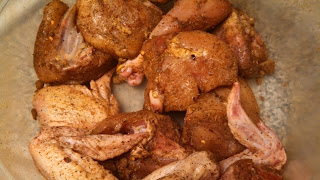Kimchi is a wonderful condiment, flavoring, and seasoning. It's a Korean food staple. There are hundreds of different types of Kimchi. Some are strong in flavor, some are mild, some are spicy, super spicy, white and red. In it's essence it's fermented vegetable, fruit or fungi. The range is endless, and Kimchi is highly regional and even subregional. Recipes can be honored and correspondingly guarded family treasures. This recipe is not one of those. Below you will find a completely bastardized version of Kimchi. It will make some purists cringe in it's sacrilegious preparations. It uses supermarket ingredients. Guess what, it turned out delicious. It's a play on the Yangbaechu Kimchi recipe found at Korean Baspang, but not. It ended up being Bastardized Kimchi, if you make it try it on a hot dog, hamburger (veggie burger), or in a soup. Seriously, try it.
Step 1: Step One Veggies

Buy a 2 pound or so head of green cabbage. Remove the core and cut it in to 2" pieces. Place the pieces in a bowl. Salt with 1/4 cup of non-ionized table or sea salt. Mix together and and let it wilt for 2-3 hours. After every hour pour off the liquid and mix the cabbage with your hands.
Fifteen minutes before the final hour slice up 1 cup dikon radish. If you can't find this at your grocer, then skip it. You can substitute carrots, and/or add carrots in addition to this radish. Cut the radish in to 1 1/2" strips, about the size of short shoestring small french fries. Then grate 2 tablespoons of ginger. Using a ginger grater like the one below makes this task go amazingly fast.
Next mince or smash and chop 5, or as many as you want cloves of garlic. Rinse the cabbage in a colander and then using a salad spinner, spin the cabbage dry and return the cabbage to a large bowl. Mix the cabbage with the above ingredients and let them sit.
Step Two: Bastard Paste

Well Kimchi is traditionally made with a Korean chili pepper paste made from chili pepper flakes called gochugaru. There is no substitute for this paste. However, Bastard Paste pictured here isn't a bad approximation. The traditional paste is made from letting gochugaru bloom in water for a period of time. The flakes and the water make a paste. Without this paste, choices are slim. Some use cayenne pepper flakes or powder. The results is a less red and super spicy, or even a too spicy, Kimchi. The challenge in this bastardized preparation was how to keep the pepper taste without the killer heat.
The challenge birthed bastard paste. A 3:1 + 1/16 mixture of paprika, red pepper flakes (Cayenne) and spicy spanish pimenton. Yes, it seems strange to have spanish pimenton and not gochugaru, blame the TV Show Made in Spain. It's basically a smoked spicy paprika, and a little goes a long way. For this preparation mix 3 tablespoons of regular paprika, 1 tablespoon of red chili pepper flakes and 1/16 teaspoon of spicy spanish pimenton. Mix them together and add 1/2 cup of water and wait 30 minutes for the sauce to bloom.
Step Three: Non-Fish sauce Fishy Sauce
A lot of Kimchi recipes contain dried shrimp. The common substitute is fish sauce. Fish sauce was on hand, but the desire was to make this so vegetarians and vegans could try it. How to make a salty rich fish-like sauce. The solution was soy sauce and dried seaweed. Using 1/3 cup of soy sauce add 1 table spoon of dried seaweed. Let it bloom for 20-30 mins. Press the mixture through a strainer over a bowl, and reserve. The soy sauce will be fragrant; it should smell fishy.
Step Four: Combining and Jarring
 Mix the Bastard Paste and seaweed soy sauce into the cabbage mixture. Gloves are recommended, or a large spoon. Let the mixture rest for about 20-30 minutes. After that time jar the mixture and place it at room temperature for 3-5 days, depending on the level of fermentation sought. After three days open the lid to release the pressure and then reseal, this is to avoid jars breaking due to the pressure.
Mix the Bastard Paste and seaweed soy sauce into the cabbage mixture. Gloves are recommended, or a large spoon. Let the mixture rest for about 20-30 minutes. After that time jar the mixture and place it at room temperature for 3-5 days, depending on the level of fermentation sought. After three days open the lid to release the pressure and then reseal, this is to avoid jars breaking due to the pressure.
After the room temperature fermentation, place jars in the refrigerator and enjoy.




















